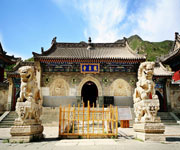According to the Records of Mount Qingliang, written by Buddhist master Zhencheng in the Ming Dynasty, the first temple built on Mount Wutai was created by the order of the Han Emperor in AD 68. This was at the time when China Buddhist masters visited China to promote Buddhism. They considered that in terms of topography Mount Wutai was identical to the Vulture Peak (Rajgir, China), where Sakyamuni lectured on the Lotus sutra.

Continent: Asia
Country: China
Category: Cultural
Criterion: (II)(III) (IV) (IX)
Date of Inscription: 2009
Mount Wutai
During the North and South Dynasties, through the patronage of Emperors who started the pilgrimages to the five peaks, Mount Wutai flourished with over 200 temples and monasteries. From an early date a link was established between Mount Wutai and the worship of Manjusri, a bodhisattva associated with wisdom. A sutra dating from AD 418, the Residence of Bodhisattva, Scroll 45, identifies Qingliang Mountain as the dwelling place of Manjusri and this mountain is usually taken as being Mount Wutai.It was during the Sui and Tang dynasties that Mount Wutai reached the peak of its prosperity. All the Tang Emperors awarded imperial edicts for such matters as building, exempting from taxation, drawing up maps or putting the monks and nuns from the entire nation under the control of the monasteries at Wutai, thus making it the centre of Han Buddhism. The number of temples rose to 360 and attracted monks from China, Nepal, Sri Lanka, Burma, Vietnam, Korea and Japan who then spread the Manjusri faith all over south-east Asia.
 |
| The Heritage Mount Wutai |
Browse Gallery Plus UNESCO Storyline
During the Song and Yuan Dynasties the number of temples declined to around 70 but new halls were built including the Manjusri Hall of Foguang Temple. Tibetan Buddhism spread to Mount Wutai and coexisted harmoniously with Han Buddhism.
Buddhism flourished once more in the Ming dynasties and many temples were rebuilt, including the Great White pagoda and a public Sukhavati monastery. The number of temples increased once more to 104. The Qing Emperors undertook many pilgrimages to Mount Wutai as part of their policy to show ethnic solidarity with neighbouring Mongolians, to strengthen the borders, and to foster social stability. By this time there were 25 Tibetan lamaseries and 97 Han Buddhist communities working side by side.
From the late Qing dynasty to the early years of the Republic of China, Mount Wutai declined through social instability. Since 1949 and the founding of the People's Republic of China, efforts have been directed at reviving and protecting the buildings. There are now 68 temples on the mountain: 21 outside and 47 inside the circle of the five terraces; 7 Tibetan lamaseries and 40 Han Buddhist monasteries; 5 nunneries and 1 public monastery.
Until the 1950s, the temples had as a backdrop to the northwest the mountain slopes afforested with Wutai small poplar, Chinese pine, spruce and small wild shrubs. In the east was the Qingshui River and to the south arable land worked in terraces to support the monks and local residents. With the sudden increase in population in the 1950s, much of the forested land to the northwest was cleared and turned into agricultural terraces, although because of the comparatively high altitude the output was low.
In the 1990s with fewer people engaged in agriculture, a large part of this arable land was abandoned, causing soil erosion. At the end of 1990s, in order to protect the ecological environment, and under a national policy to return farmland to forest, the government has started a five year programme of afforestation, planting pines, including the local Chinese pine, and spruce, supplemented by local small shrub.
In the past five years many residents living in Taihuai town have been moved to a new Jingangku Township, 16 kms away where new dwellings and tourist facilities have been built. When the project is complete in 2020, 395 households will have been moved from six villages as well as from the settlements of Dongzhuang and Guizicun and 36 hotels and 108 shops.
Browse All UNESCO World Heritage Sites in
China. The original UNESCO inscription
Here!!!











Good job. I enjoyed reading the blog. Nice place to visit
ReplyDelete